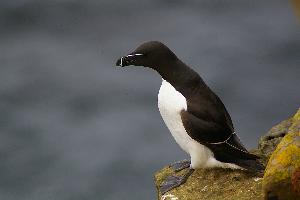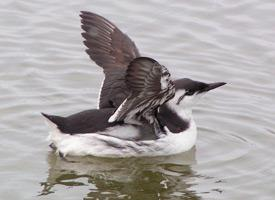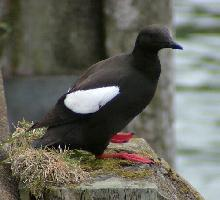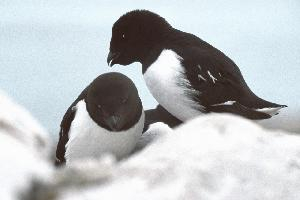
Váhy a míry
| Délka | od 38 do 42 cm |
|---|---|
| Délka rozpětí křídel | od 60 do 69 cm |
Popis zvířete
The Razorbill (Alca torda) is a captivating seabird, known for its striking appearance and unique behaviors, which inhabits the temperate and cold waters of the Atlantic Ocean. This medium-sized bird, part of the Alcidae family, which also includes puffins and guillemots, plays a significant role in the marine ecosystem. With its distinctive silhouette and intriguing life cycle, the Razorbill has become a subject of interest for birdwatchers and conservationists alike.Physical Description:
Razorbills are robust birds, measuring approximately 38 to 43 centimeters in length, with a wingspan of around 63 to 73 centimeters. They are characterized by their deep black upperparts and clean white underparts, creating a stark contrast that is especially visible during flight. One of the most notable features of the Razorbill is its thick, black bill which is deep and appears almost blunt, resembling the blade of a razor, hence its name. During the breeding season, an additional white line decorates the bill, adding to its striking appearance. Their eyes are encircled by a thin, white line, which stands out against their dark feathers.
Habitat and Distribution:
Razorbills are true seabirds, spending the majority of their lives on the open ocean, except during the breeding season. They are predominantly found in the North Atlantic Ocean, from the eastern coast of North America to the western coasts of Europe and the British Isles. During breeding, they favor rocky cliffs and islands, where they nest in crevices or under rocks, forming large, dense colonies. These sites are typically chosen for their proximity to the sea, allowing for easy access to their feeding grounds.
Behavior and Diet:
Razorbills are exceptional divers, capable of reaching depths of up to 120 meters in pursuit of their prey, though they more commonly forage at shallower depths. Their diet primarily consists of small fish, such as sand eels, herring, and capelin, which they catch with their strong, adept bills. They are known to be monogamous, often forming long-term pair bonds, with both parents sharing responsibilities for incubating the egg and feeding the chick.
Reproduction:
The breeding season for Razorbills begins in late spring and early summer. They lay a single egg per season, which is notable for its pear shape and varied coloration, ranging from white to a greenish or brownish hue, often speckled with dark spots. This unique shape prevents the egg from rolling off the cliff edges or rocky surfaces. After an incubation period of approximately 35 to 39 days, the chick hatches. Razorbill chicks are semi-precocial, meaning they are relatively mature and mobile from birth but still rely on their parents for food and protection. Remarkably, after just a few weeks, the chick will leave the nest and venture into the sea with its father, where it continues to be cared for until it can fend for itself.
Conservation Status:
The Razorbill is currently classified as Least Concern by the International Union for Conservation of Nature (IUCN), indicating that it is not at immediate risk of extinction. However, like many seabird species, Razorbills face threats from oil spills, overfishing, which depletes their food sources, and climate change, which affects their breeding habitats and prey availability. Conservation efforts are focused on protecting their breeding sites and ensuring sustainable fishery practices to preserve these remarkable birds for future generations.
In conclusion, the Razorbill is a fascinating and resilient seabird, embodying the harsh beauty and complexity of marine ecosystems. Its distinct appearance, intriguing behaviors, and the challenges it faces in the changing world make it a symbol of the need for continued conservation efforts in our oceans.
Podobná zvířata
Nové fotografie zvířat
Top 10 zvířat
- Chinese water dragon (Physignathus cocincinus)
- Galápagos tortoise (Geochelone nigra complex)
- Dolphin gull (Leucophaeus scoresbii)
- Japanese macaque (Macaca fuscata)
- Colombian red howler (Alouatta seniculus)
- Sea urchins (Echinoidea)
- Moustached guenon (Cercopithecus cephus)
- Diana monkey (Cercopithecus diana)
- Common reed warbler (Acrocephalus scirpaceus)
- Common house mosquito (Culex pipiens)


